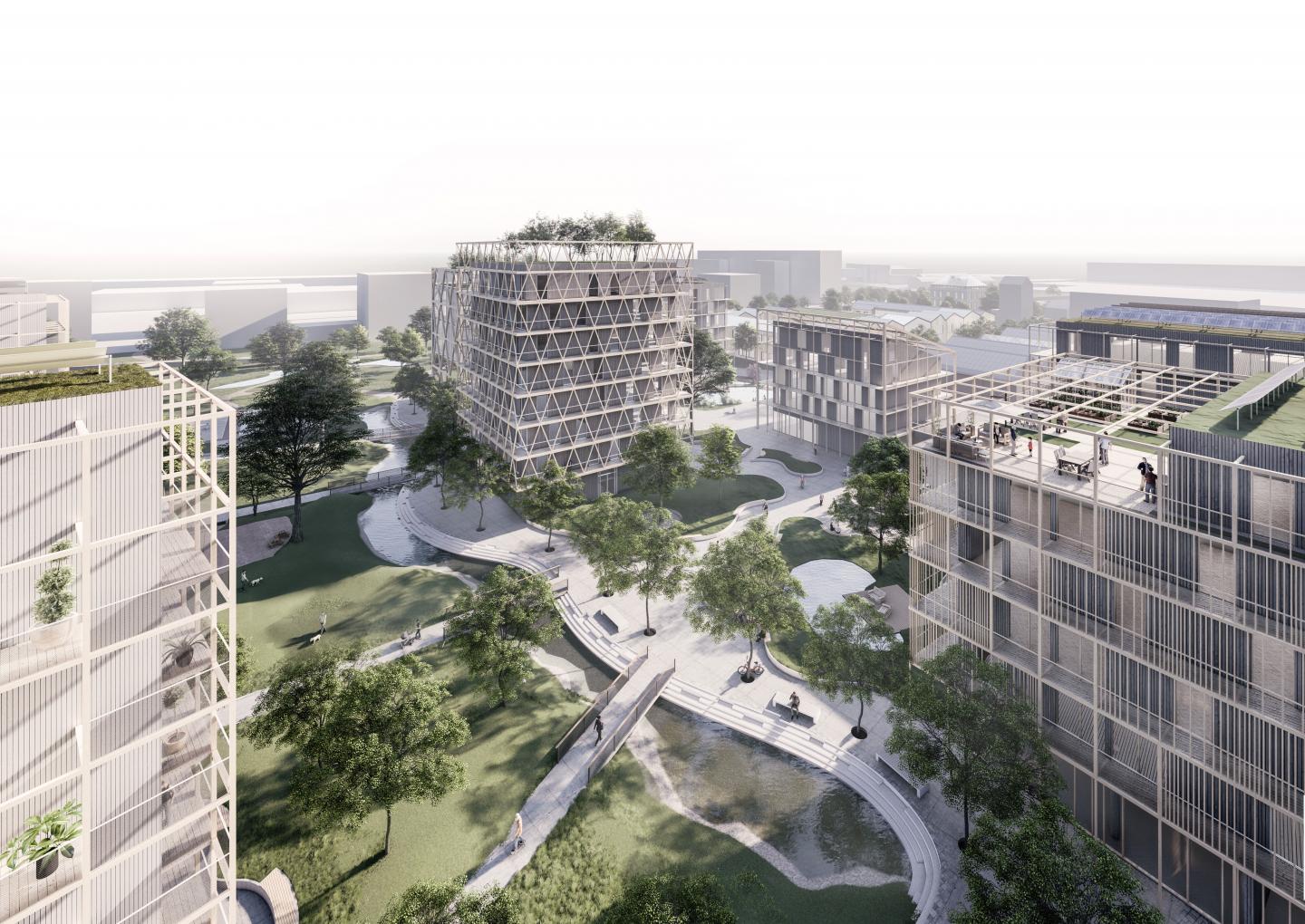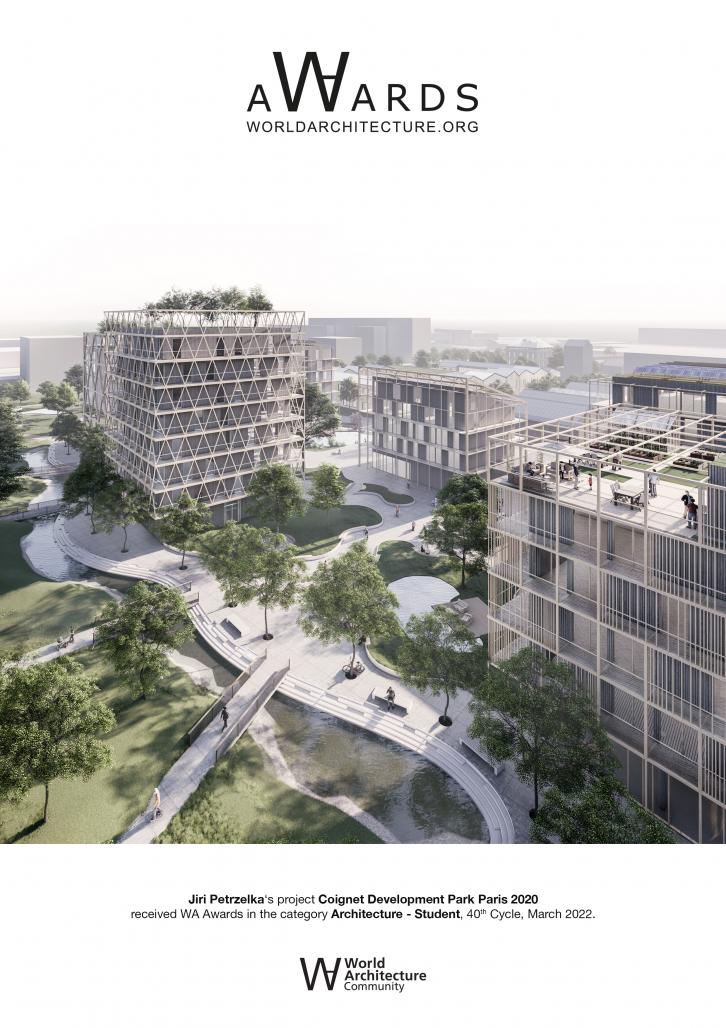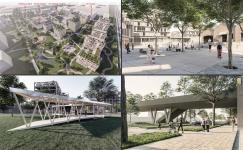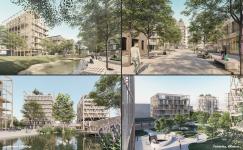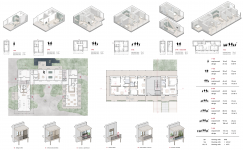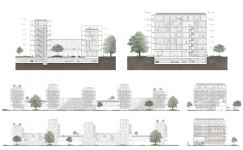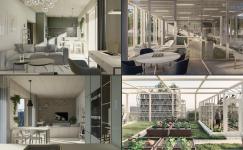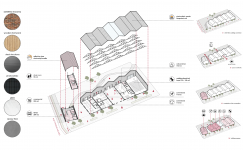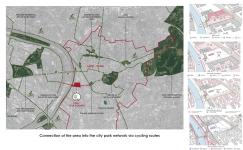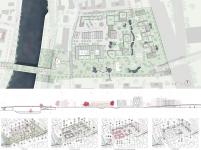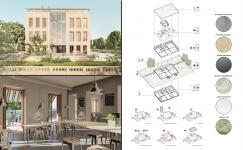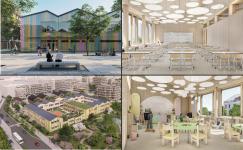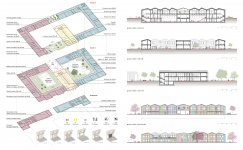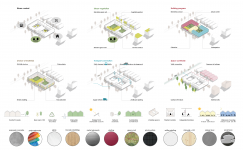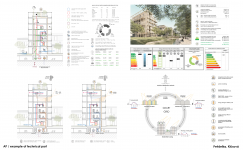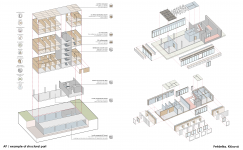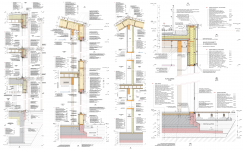The new sustainable district of Saint Denis is a city of short distances, where man is the main measure of space. It offers a new home for more than 1,000 inhabitants, along with education, cultural or recreational activities. There is a synergy of post-industrial heritage buildings, which we have breathed new life into, and new sustainable buildings in accordance with respect for historical values in the area.
The key to solving the area was a completely comprehensive approach, from the analytical part to the final architectural or structural design of buildings. We defined the key problems and potentials, the relationship of the area to the surroundings and decided to plant the currently cut and dead area in the network of city parks in Paris. We have made the area accessible by transforming brownfields into urban development, designing new transport and pedestrian connections and, most importantly, designing green bridges over the river and the railway.
Based on the created concepts of sustainability and the study of the company, we created the composition of the living image of the city. The composition consists of a mixture of functional content of spaces, community and commercial spaces on the ground floor, variably usable public spaces and cultural buildings with all-day use. We create a rich and safe urban space, full of vivid vistas and we aim for the social interaction of the inhabitants.
Part of the design is a kindergarten with a school that responds to the form and scale of industrial heritage buildings. The conversion of industrial warehouses offers variable and flexible use of spaces that open up to the exterior as much as possible and connect individual urban spaces. Through the conversion, we aimed to preserve historical values and inhale the ability to constantly adapt over time. The same approach is applied to the villa Maison La Coignet, which becomes a sightseeing landmark of the park. The concept of a roof landscape form green roofs, community gardens or photovoltaic power plants, which are possibly integrated as roofing. The height and scale of the development tastefully fit into the whole urban context.
Our goal was to create a partially energy self-sufficient neighborhood, which will consist of low-carbon buildings. We focused on the use of natural and recycled materials and the recognition of building structures. For new buildings, it is aimed at maximum prefabrication, minimizing the wet process on the construction site, the use of local products and companies to create a minimum carbon footprint associated with transport and logistics activities on the construction site. When designing new buildings with a wooden supporting structure, we also considered the future recycling and demolition of buildings. We have breathed new variable and flexible use into the existing objects of industrial heritage. We used to open private objects to people with the possibility of constantly adapting the function.The newly designed buildings are designed as extremely economical passive houses with partial energy self-sufficiency. Saddle roofs were designed as an integrated covering of photovoltaic panels. The produced electricity is used directly in the building or accumulated in the battery storage. Excess energy is shared between objects as needed using a smart grid network. We aim for self-sufficiency and efficient use of energy without waste.The city of short distances minimizes the need for individual car transport. The urban space is thus taught to people and not cars.
The project is prepared in the form of presentation panels and a 130-page book. The content of the book consists of an intro, analytical part, ubranism part, architectural part - apartment houses, groupe scolaire, reconstruction of industrial warehouses and villas La Maison Coignet. Other parts are the construction and the technical part of selected objects -construction, daylight, ventilation, acoustics, fire safety, etc., price calculation and drawings of construction details.
This is a student competition project that won the Czech ecological energy project of 2020, the best student architectural project of 2020 and so far several nominations for student architectural awards.We presented the project publicly several times and appeared in several online pages about architecture. We were also invited as a speaker to an international conference on passive houses in 2021.
We also want to complete the idea of operating areas such as the Olympic Fan Village. This is an exceptional event that will bring life to the whole area and then turn it into a residential district. That will prevent the formation of "dead Olympic buildings."
We are both students from the Czech Republic, where there are many similar brownfields. They are near rivers and urban centers that create flat or linear barriers in a network of urban roads. These are often places with interesting industrial architecture, which has great potential and should be appreciated. It's our human history. Extensive facilities offer variable open spaces that can be easily connected to city centers or roads. The problem is property relations and renovation work, and the relationship of the inhabitants to these buildings, which often look scary. The vision of our project can be applied to brownfields in the Czech Republic, or bring a solution for the revision of prefabricated houses from the communist period. We want to design and present a concept of solving similar places in our country... Or in entire EU?
2019
2020
Video presentation:
https://www.youtube.com/watch?v=k8yknAKHzlg&ab_channel=JiříPetrželka
We design buildings with a minimum carbon footprint. This is mainly due to the use of wood-based materials as the main construction material and the targeted use of natural and recycled materials from local companies and suppliers. Concrete structures are designed only on the first floor and communication cores as a reference to the historical tradition of the place and to ensure the fire safety of buildings. Thanks to the milder fire standard in France, it is not a problem to design such floor buildings from recognized CLT panels. For example, the Groupe Scolaire building is designed as a glued wood frame with an envelope made of prefabricated modular panels of a light wood-based perimeter cladding, which will significantly speed up the construction process. Part of the sustainable architecture is inextricable thermal comfort and a quality indoor environment. We have achieved this with high-quality thermal insulation properties of building envelopes and solutions for all key details. Due to the chosen solution of the wooden building
we paid attention to the solution of acoustic comfort and fire safety of buildings. Ventilation is a combination of controlled and natural ventilation. Heating and hot water provide renewable energy sources and thanks to the recycling of gray water, we have achieved 40% savings in drinking
water from the order. Rainwater is accumulated in public water features or on green roofs and is used to cool and improve the microclimate throughout the area. The produced electricity is used directly in buildings or accumulated in the battery storage. Energy is shared through a smart grid network between objects with a family peak day. The result of the entire design are buildings with extremely low energy needs for heating and possible self-sufficiency. Designed objects have a heat demand for heating less than 15kwh/m2.a.
Situation size 7,5ha, park are 2,5 ha, 261 housing unit, 1044 residents, 249 parking places, 20 barrier-free parking places, 50 motocycle parking place. Groupe scolaire is education building for 600 pupils. Indoor playing space for pupils 4235m2, outdoor playing space 2122m2.
Author: Jiří Petrželka
co-author: Kristýna Klůsová
Supervised by:
Ing. arch. Josef Smola
Ing. arch. Martin Stark
Pedagogical team:
Ing. arch. Josef Smola
Ing. arch. Martin Stark
Akad. Arch. Aleš Brotánek
Ing. Jiří Tencar, Ph.D.,
Ing. Jiří Novák, Ph.D.
departnent of architecture, Faculty of Civil Engineering, CTU in Prague
Coignet Development Park Paris 2020 by Jiri Petrzelka in France won the WA Award Cycle 40. Please find below the WA Award poster for this project.
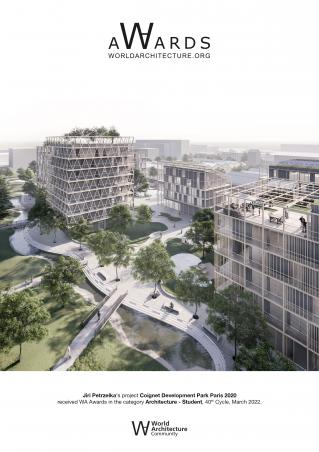
Downloaded 0 times.
